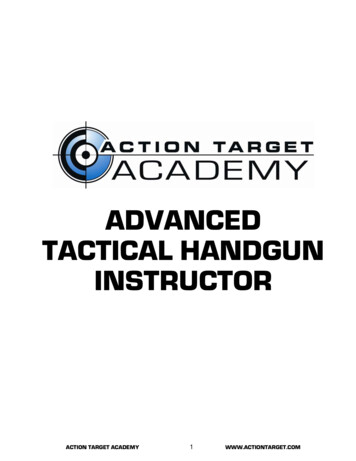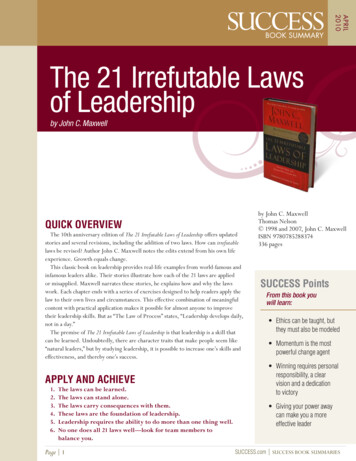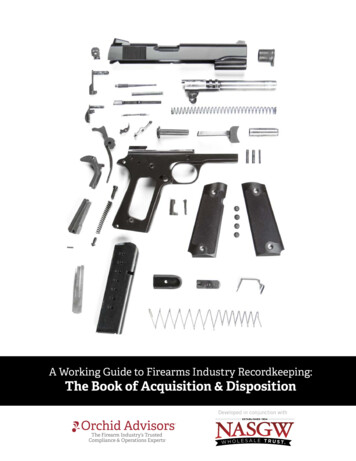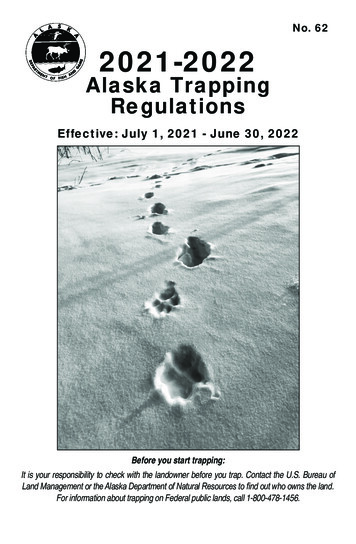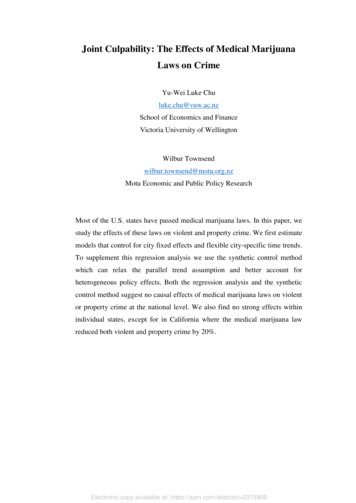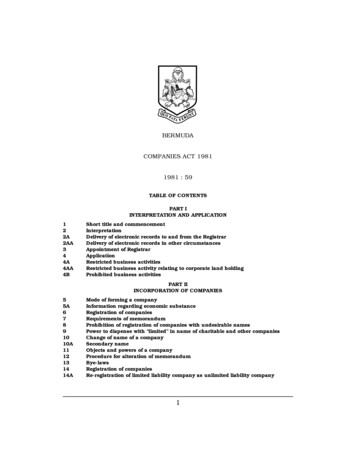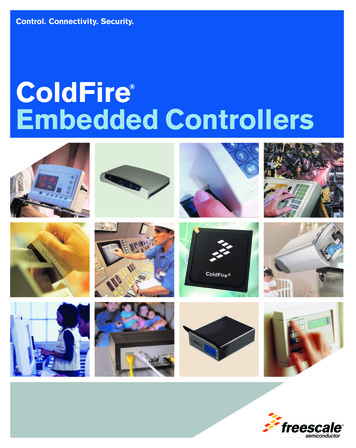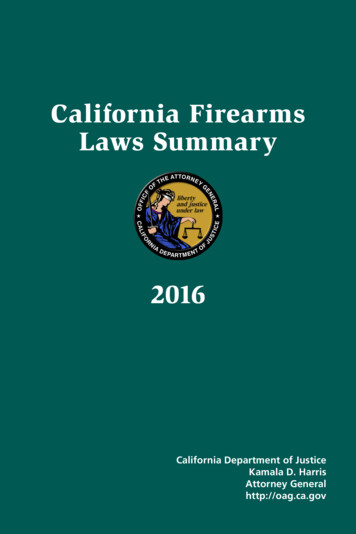
Transcription
California FirearmsLaws Summary2016California Department of JusticeKamala D. HarrisAttorney Generalhttp://oag.ca.gov
Table of ContentsCalifornia Firearms Laws Summary 2016Introduction . . . . . . . . . . . . . . . . . . . . . . . . . . . . . . . . . . . . . . . . 1Persons Ineligible to Possess Firearms . . . . . . . . . . . . . . . . . . . . . 1Sales and Transfers of Firearms . . . . . . . . . . . . . . . . . . . . . . . . . . 3Prohibited Firearms Transfers and Straw Purchases . . . . . . . . . . . . 5Reporting Requirements for New California Residents . . . . . . . . . . 6Shipment of Firearms . . . . . . . . . . . . . . . . . . . . . . . . . . . . . . . . . 6Carrying Firearms Aboard Common Carriers . . . . . . . . . . . . . . . . . 7Firearms in the Home, Business or at the Campsite . . . . . . . . . . . . 7Transportation of Firearms . . . . . . . . . . . . . . . . . . . . . . . . . . . . . . 7Use of Lethal Force in Self-Defense . . . . . . . . . . . . . . . . . . . . . . . . 8Carrying a Concealed Weapon Without a License . . . . . . . . . . . . 10Loaded Firearms in Public . . . . . . . . . . . . . . . . . . . . . . . . . . . . . 10Openly Carrying an Unloaded Handgun . . . . . . . . . . . . . . . . . . . .11Punishment for Carrying Unregistered Handgun . . . . . . . . . . . . . 11Miscellaneous Prohibited Acts . . . . . . . . . . . . . . . . . . . . . . . . . . 12New Firearms/Weapons Laws . . . . . . . . . . . . . . . . . . . . . . . . . . 14
California Firearms LawsSummary 2016INTRODUCTIONAs the owner of a firearm, it is your responsibility to understand and complywith all federal, state and local laws regarding firearms ownership . Many of thelaws described below pertain to the possession, use and storage of firearms in thehome and merit careful review . The California Firearms Laws Summary 2016provides a general summary of California laws that govern common possessionand use of firearms by persons other than law enforcement officers or membersof the armed forces . It is not designed to provide individual guidance for specificsituations, nor does it address federal or local laws . The legality of any specificact of possession or use will ultimately be determined by applicable federal andstate statutory and case law . Persons having specific questions are encouraged toseek legal advice from an attorney, or consult their local law enforcement agency,local prosecutor or law library . The California Department of Justice (DOJ) andall other public entities are immune from any liability arising from the drafting,publication, dissemination, or reliance upon this information .PERSONS INELIGIBLE TO POSSESS FIREARMSThe following persons are prohibited from possessing firearms (Pen . Code, §§29800-29825, 29900; Welf . & Inst . Code, §§ 8100, 8103):Lifetime Prohibitions Any person convicted of any felony or any offense enumerated in PenalCode section 29905 . Any person convicted of an offense enumerated in Penal Code section23515 . Any person with two or more convictions for violating Penal Code section417, subdivision (a)(2) . Any person adjudicated to be a mentally disordered sex offender . (Welf . &Inst . Code, § 8103, subd . (a)(1) .) Any person found by a court to be mentally incompetent to stand trial ornot guilty by reason of insanity of any crime, unless the court has made afinding of restoration of competence or sanity . (Welf . & Inst . Code, § 8103,subds . (b)(1), (c)(1), and (d)(1) .)1
10-Year Prohibitions Any person convicted of a misdemeanor violation of the following: PenalCode sections 71, 76, 136 .5, 140, 148, subdivision (d), 171b, 171c, 171d,186 .28, 240, 241, 242, 243, 244 .5, 245, 245 .5, 246, 246 .3, 247, 273 .5,273 .6, 417, 417 .1, 417 .2, 417 .6, 422, 626 .9, 646 .9, 830 .95, subdivision (a),17500, 17510, subdivision (a), 25300, 25800, 27510, 27590, subdivision(c), 30315, or 32625, and Welfare and Institutions Code sections 871 .5,1001 .5, 8100, 8101, or 8103 .5-Year Prohibitions Any person taken into custody as a danger to self or others, assessed, andadmitted to a mental health facility under Welfare and Institutions Codesections 5150, 5151, 5152; or certified under Welfare and Institutions Codesections 5250, 5260, 5270 .15 . Persons certified under Welfare andInstitutions Code sections 5250, 5260, or 5270 .15 may be subject to alifetime prohibition pursuant to federal law .Juvenile Prohibitions Juveniles adjudged wards of the juvenile court are prohibited until theyreach age 30 if they committed an offense listed in Welfare andInstitutions Code section 707, subdivision (b) . (Pen . Code, § 29820 .)Miscellaneous Prohibitions Any person denied firearm possession as a condition of probationpursuant to Penal Code section 29900, subdivision (c) . Any person charged with a felony offense, pending resolution of thematter . (18 U .S .C . § 922(g) .) Any person while he or she is either a voluntary patient in a mental healthfacility or under a gravely disabled conservatorship (due to a mentaldisorder or impairment by chronic alcoholism) and if he or she is foundto be a danger to self or others . (Welf . & Inst . Code, § 8103, subd . (e) .) Any person addicted to the use of narcotics . (Pen . Code, § 29800, subd . (a) .) Any person who communicates a threat (against any reasonablyidentifiable victim) to a licensed psychotherapist which is subsequentlyreported to law enforcement, is prohibited for six months . (Welf . & Inst .Code, § 8100, subd . (b) .) Any person who is subject to a protective order as defined in Family Codesection 6218 or Penal Code section 136 .2, or a temporary restraining orderissued pursuant to Code of Civil Procedure sections 527 .6 or 527 .8 .Personal Firearms Eligibility CheckAny person may obtain from the DOJ a determination as to whether he or she iseligible to possess firearms (review of California records only) . The personalfirearms eligibility check application form and instructions are on the DOJ websiteat http://oag .ca .gov/firearms/forms . The cost for such an eligibility check is 20 .(Pen . Code, § 30105 .)2
SALES AND TRANSFERS OF FIREARMSIn California, only licensed California firearms dealers who possess a validCertificate of Eligibility (COE) are authorized to engage in retail sales of firearms .These retail sales require the purchaser to provide personal identifier informationfor the Dealer Record of Sale (DROS) document that the firearms dealer mustsubmit to the DOJ . There is a mandatory 10-day waiting period before the firearmsdealer can deliver the firearm to the purchaser . During this 10-day waiting period,the DOJ conducts a firearms eligibility background check to ensure the purchaseris not prohibited from lawfully possessing firearms . Although there are exceptions,generally all firearms purchasers must be at least 18 years of age to purchase along gun (rifle or shotgun) and 21 years of age to purchase a handgun (pistol orrevolver) . Additionally, purchasers must be California residents with a validdriver’s license or identification card issued by the California Department ofMotor Vehicles .Generally, it is illegal for any person who is not a California licensed firearmsdealer (private party) to sell or transfer a firearm to another non-licensed person(private party) unless the sale or transfer is completed through a licensedCalifornia firearms dealer . A “Private Party Transfer” (PPT) can be conducted atany licensed California firearms dealership . The buyer and seller must completethe required DROS document in person at the licensed firearms dealership anddeliver the firearm to the dealer who will retain possession of the firearm duringthe mandatory 10-day waiting period . In addition to the applicable state fees, thefirearms dealer may charge a fee not to exceed 10 per firearm for conducting thePPT .The infrequent transfer of firearms between immediate family members is exemptfrom the law requiring PPTs to be conducted through a licensed firearms dealer .For purposes of this exemption, “immediate family member” means parent andchild, and grandparent and grandchild but does not include brothers or sisters .(Pen . Code, § 16720 .) The transferee must also comply with the Firearm SafetyCertificate requirement described below, prior to taking possession of the firearm .Within 30 days of the transfer, the transferee must also submit a report of thetransaction to the DOJ . Download the form (Report of Operation of Law or IntraFamilial Firearm Transaction BOF 4544A) from the DOJ website athttp://oag .ca .gov/firearms/forms or complete and submit the form electronicallyvia the internet at https://CFARS .doj .ca .gov .The reclaiming of a pawned firearm is subject to the DROS and 10-day waitingperiod requirements .Specific statutory requirements relating to sales and transfers of firearms follow:Proof-of-Residency RequirementTo purchase a handgun in California, you must present documentation indicatingthat you are a California resident . Acceptable documentation includes a utilitybill from within the last three months, a residential lease, a property deed ormilitary permanent duty station orders indicating assignment within California .3
The address provided on the proof-of-residency document must match either theaddress on the DROS or the address on the purchaser’s California driver's licenseor identification card . (Pen . Code, § 26845 .)Firearm Safety Certificate RequirementTo purchase or acquire a firearm, you must have a valid Firearm Safety Certificate(FSC) . To obtain an FSC, you must score at least 75% on an objective written testpertaining to firearms laws and safety requirements . The test is administered byDOJ Certified Instructors, who are often located at firearms dealerships . An FSCis valid for five years . You may be charged up to 25 for an FSC . Firearms beingreturned to their owners, such as pawn returns, are exempt from this requirement .In the event of a lost, stolen or destroyed FSC, the issuing DOJ Certified Instructorwill issue a replacement FSC for a fee of 5 . You must present proof of identity toreceive a replacement FSC . (Pen . Code, §§ 31610-31670 .)Safe Handling Demonstration RequirementPrior to taking delivery of a firearm, you must successfully perform a safehandling demonstration with the firearm being purchased or acquired . Safehandling demonstrations must be performed in the presence of a DOJ CertifiedInstructor sometime between the date the DROS is submitted to the DOJ and thedelivery of the firearm, and are generally performed at the firearms dealership .The purchaser, firearms dealer and DOJ Certified Instructor must sign an affidavitstating the safe handling demonstration was completed . The steps required tocomplete the safe handling demonstration are described in the Appendix . Pawnreturns and intra-familial transfers are not subject to the safe handling demonstrationrequirement . (Pen . Code, § 26850 .)Firearms Safety Device RequirementAll firearms (long guns and handguns) purchased in California must beaccompanied with a firearms safety device (FSD) that has passed required safetyand functionality tests and is listed on the DOJ’s official roster of DOJ-approvedfirearm safety devices . The current roster of certified FSDs is available on the DOJwebsite at http://oag .ca .gov/firearms/fsdcertlist . The FSD requirement also canbe satisfied if the purchaser signs an affidavit declaring ownership of either aDOJ-approved lock box or a gun safe capable of accommodating the firearmbeing purchased . Pawn returns and intra-familial transfers are not subject to theFSD requirement . (Pen . Code, §§ 23635-23690 .)Roster of Handguns Certified for Sale in CaliforniaNo handgun may be sold by a firearms dealer to the public unless it is of a makeand model that has passed required safety and functionality tests and is listedon the DOJ’s official roster of handguns certified for sale in California . The currentroster of handguns certified for sale in California is on the DOJ website athttp://certguns .doj .ca .gov/ . PPTs, intrafamilial transfers, and pawn/consignmentreturns are exempt from this requirement . (Pen . Code, § 32000 .)4
One-Handgun-per-30-Days LimitNo person shall make an application to purchase more than one handgun withinany 30-days period . Exemptions to the one-handgun-per-30-days limit includepawn returns, intra-familial transfers and private party transfers . (Pen . Code,§ 27540 .)Handgun Sales and Transfer RequirementsRetailSalesPrivateIntra-familialParty Transfers esYesNoYesFirearm SafetyCertificate RequirementYesYesYesNoSafe HandlingDemonstration RequirementYesYesNoNoFirearm SafetyDevice RequirementYesYesNoNoRoster of Handguns Certifiedfor Sale in CaliforniaYesNoNoNoOne-Handgun-Per 30-Days LimitYesNoNoNoLong Gun Sales and Transfer RequirementsRetailSalesPrivateIntra-familialParty Transfers oNoNoNoFirearm SafetyCertificate RequirementYesYesYesNoSafe HandlingDemonstration RequirementYesYesNoNoFirearm SafetyDevice RequirementYesYesNoNoPROHIBITED FIREARMS TRANSFERS AND STRAW PURCHASESWhat is a straw purchase?A straw purchase is buying a firearm for someone who is prohibited by law frompossessing one, or buying a firearm for someone who does not want his or hername associated with the transaction .5
It is a violation of California law for a person who is not licensed as a Californiafirearms dealer to transfer a firearm to another unlicensed person, withoutconducting such a transfer through a licensed firearms dealer . (Pen . Code,§ 27545 .) Such a transfer may be punished as a felony . (Pen . Code, § 27590 .)Furthermore, it is a violation of federal law to either (1) make a false or fictitiousstatement on an application to purchase a firearm about a material fact, such asthe identify of the person who ultimately will acquire the firearm (commonlyknown as "lying and buying") (18 U .S .C . 922(a)(6)), or (2) knowingly transfera firearm to a person who is prohibited by federal law from possessing andpurchasing it . (18 U .S .C . 922(d) .) Such transfers are punishable under federal lawby a 250,000 fine and 10 years in federal prison . (18 U .S .C . 924(a)(2) .)Things to Remember About Prohibited Firearms Transfers and Straw PurchasesAn illegal firearm purchase (straw purchase) is a federal crime .An illegal firearm purchase can bring a felony conviction sentence of 10 years injail and a fine of up to 250,000 .Buying a gun and giving it to someone who is prohibited from owning one is astate and federal crime .Never buy a gun for someone who is prohibited by law or unable to do so.REPORTING REQUIREMENTS FOR NEW CALIFORNIA RESIDENTSNew California residents must report their ownership of firearms to the DOJ orsell/transfer them in accordance with California law, within 60 days of bringingthe firearm into the state . Persons who want to keep their firearms must submit aNew Resident Firearm Ownership Report (BOF 4010A), along with a 19 fee, tothe DOJ . Forms are available at licensed firearms dealers, the Department ofMotor Vehicles or on-line at the DOJ website at http://oag .ca .gov/firearms/forms .Forms may also be completed and submitted electronically via the internet athttps://CFARS .doj .ca .gov (Pen . Code, § 27560 .)SHIPMENT OF FIREARMSLong guns may be mailed through the U .S . Postal Service, as well as most privateparcel delivery services or common carriers . Handguns may not be sent throughthe U .S . Postal Service . A common or contract carrier must be used for shipmentof handguns . However, pursuant to federal law, non-licensees may ship handgunsonly to persons who hold a valid Federal Firearms License (FFL) .Both in-state and out-of-state FFL holders are required to obtain approval (e .g ., aunique verification number) from the California DOJ prior to shipping firearms toany California FFL . (Pen . Code, § 27555 .)6
CARRYING FIREARMS ABOARD COMMON CARRIERSFederal and state laws generally prohibit a person from carrying any firearm orammunition aboard any commercial passenger airplane . Similar restrictions mayapply to other common carriers such as trains, ships and buses . Persons who needto carry firearms or ammunition on a common carrier should always consult thecarrier in advance to determine conditions under which firearms may betransported .FIREARMS IN THE HOME, BUSINESS OR AT THE CAMPSITEUnless otherwise unlawful, any person over the age of 18 who is not prohibitedfrom possessing firearms may have a loaded or unloaded firearm at his or herplace of residence, temporary residence, campsite or on private property ownedor lawfully possessed by the person . Any person engaged in lawful business(including nonprofit organizations) or any officer, employee or agent authorizedfor lawful purposes connected with the business may have a loaded firearmwithin the place of business if that person is over 18 years of age and not otherwiseprohibited from possessing firearms . (Pen . Code, §§ 25605, 26035 .)NOTE: If a person’s place of business, residence, temporary residence, campsiteor private property is located within an area where possession of a firearm isprohibited by local or federal laws, such laws would prevail .TRANSPORTATION OF FIREARMSHandgunsCalifornia Penal Code section 25400 does not prohibit a citizen of the UnitedStates over 18 years of age who is in lawful possession of a handgun, and whoresides or is temporarily in California, from transporting the handgun by motorvehicle provided it is unloaded and stored in a locked container . (Pen . Code,§ 25610 .)The term "locked container" means a secure container which is fully enclosedand locked by a padlock, key lock, combination lock, or similar locking device .This includes the trunk of a motor vehicle, but does not include the utility orglove compartment . (Pen . Code, § 16850 .)Rifles and ShotgunsNonconcealable firearms (rifles and shotguns) are not generally covered withinthe provisions of California Penal Code section 25400 and therefore are notrequired to be transported in a locked container . However, as with any firearm,nonconcealable firearms must be unloaded while they are being transported . Arifle or shotgun that is defined as an assault weapon pursuant to Penal Codesection 30510 or 30515 must be transported in accordance with Penal Codesection 25610 .7
Registered Assault Weapons and .50 BMG RiflesRegistered assault weapons and registered .50 BMG rifles may be transportedonly between specified locations and must be unloaded and in a locked containerwhen transported . (Pen . Code, § 30945, subd . (g) .)The term "locked container" means a secure container which is fully enclosedand locked by a padlock, key lock, combination lock, or similar locking device .This includes the trunk of a motor vehicle, but does not include the utility orglove compartment . (Pen . Code, § 16850 .)USE OF LETHAL FORCE IN SELF-DEFENSEThe question of whether use of lethal force is justified in self-defense cannotbe reduced to a simple list of factors . This section is based on the instructionsgenerally given to the jury in a criminal case where self-defense is claimed andillustrates the general rules regarding the use of lethal force in self-defense .Permissible Use of Lethal Force in Defense of Life and BodyThe killing of one person by another may be justifiable when necessary to resistthe attempt to commit a forcible and life-threatening crime, provided that areasonable person in the same or similar situation would believe that (a) theperson killed intended to commit a forcible and life-threatening crime; (b) therewas imminent danger of such crime being accomplished; and (c) the personacted under the belief that such force was necessary to save himself or herself oranother from death or a forcible and life-threatening crime . Murder, mayhem,rape and robbery are examples of forcible and life-threatening crimes . (Pen .Code, § 197 .)Self-Defense Against AssaultIt is lawful for a person being assaulted to defend themself from attack if he orshe has reasonable grounds for believing, and does in fact believe, that he or shewill suffer bodily injury . In doing so, he or she may use such force, up to deadlyforce, as a reasonable person in the same or similar circumstances would believenecessary to prevent great bodily injury or death . An assault with fists does notjustify use of a deadly weapon in self-defense unless the person being assaultedbelieves, and a reasonable person in the same or similar circumstances wouldalso believe, that the assault is likely to inflict great bodily injury .It is lawful for a person who has grounds for believing, and does in fact believe,that great bodily injury is about to be inflicted upon another to protect the victimfrom attack . In so doing, the person may use such force as reasonably necessaryto prevent the injury . Deadly force is only considered reasonable to prevent greatbodily injury or death .NOTE: The use of excessive force to counter an assault may result in civil orcriminal penalties .8
Limitations on the Use of Force in Self-DefenseThe right of self-defense ceases when there is no further danger from an assailant .Thus, where a person attacked under circumstances initially justifying self-defenserenders the attacker incapable of inflicting further injuries, the law of self-defenseceases and no further force may be used . Furthermore, a person may only use theamount of force, up to deadly force, as a reasonable person in the same or similarcircumstances would believe necessary to prevent imminent injury . It is importantto note the use of excessive force to counter an assault may result in civil orcriminal penalties .The right of self-defense is not initially available to a person who assaults another .However, if such a person attempts to stop further combat and clearly informsthe adversary of his or her desire for peace but the opponent neverthelesscontinues the fight, the right of self-defense returns and is the same as the rightof any other person being assaulted .Protecting One’s HomeA person may defend his or her home against anyone who attempts to enter ina violent manner intending violence to any person in the home . The amount offorce that may be used in resisting such entry is limited to that which wouldappear necessary to a reasonable person in the same or similar circumstances toresist the violent entry . One is not bound to retreat, even though a retreat mightsafely be made . One may resist force with force, increasing it in proportion to theintruder's persistence and violence, if the circumstances apparent to the occupantwould cause a reasonable person in the same or similar situation to fear for his orher safety .The occupant may use a firearm when resisting the intruder's attempt to commita forcible and life-threatening crime against anyone in the home provided that areasonable person in the same or similar situation would believe that (a) theintruder intends to commit a forcible and life-threatening crime; (b) there isimminent danger of such crime being accomplished; and (c) the occupant actsunder the belief that use of a firearm is necessary to save himself or herself oranother from death or great bodily injury . Murder, mayhem, rape, and robberyare examples of forcible and life-threatening crimes .Any person using force intended or likely to cause death or great bodily injurywithin his or her residence shall be presumed to have held a reasonable fear ofimminent peril of death or great bodily injury to self, family, or a member of thehousehold when that force is used against another person, not a member of thefamily or household, who unlawfully and forcibly enters or has unlawfully andforcibly entered the residence and the person using the force knew or had reasonto believe that an unlawful and forcible entry had occurred . Great bodily injurymeans a significant or substantial physical injury . (Pen . Code, § 198 .5 .)NOTE: If the presumption is rebutted by contrary evidence, the occupant may becriminally liable for an unlawful assault or homicide .9
Defense of PropertyThe lawful occupant of real property has the right to request a trespasser to leavethe premises . If the trespasser does not do so within a reasonable time, theoccupant may use force to eject the trespasser . The amount of force that may beused to eject a trespasser is limited to that which a reasonable person wouldbelieve to be necessary under the same or similar circumstances .CARRYING A CONCEALED WEAPON WITHOUT A LICENSEIt is illegal for any person to carry a handgun concealed upon his or her personor concealed in a vehicle without a license issued pursuant to Penal Code section26150 . (Pen . Code, § 25400 .) A firearm locked in a motor vehicle’s trunk or in alocked container carried in the vehicle other than in the utility or glove compart ment is not considered concealed within the meaning of the Penal Code section25400; neither is a firearm carried within a locked container directly to or from amotor vehicle for any lawful purpose . (Pen . Code, § 25610 .)The prohibition from carrying a concealed handgun does not apply to licensedhunters or fishermen while engaged in hunting or fishing, or while going to orreturning from the hunting expedition . (Pen . Code, § 25640 .) Notwithstandingthis exception for hunters or fishermen, these individuals may not carry ortransport loaded firearms when going to or from the expedition . The unloadedfirearms should be transported in the trunk of the vehicle or in a locked containerother than the utility or glove compartment . (Pen . Code, § 25610 .)There are also occupational exceptions to the prohibition from carrying aconcealed weapon, including authorized employees while engaged in specifiedactivities . (Pen . Code, §§ 25630, 25640 .)LOADED FIREARMS IN PUBLICIt is illegal to carry a loaded firearm on one’s person or in a vehicle while in anypublic place, on any public street, or in any place where it is unlawful to dischargea firearm . (Pen . Code, § 25850, subd . (a) .)It is illegal for the driver of any motor vehicle, or the owner of any motor vehicleirrespective of whether the owner is occupying the vehicle to knowingly permitany person to carry a loaded firearm into the vehicle in violation of Penal Codesection 25850, or Fish and Game Code section 2006 . (Pen . Code, § 26100 .)A firearm is deemed loaded when there is a live cartridge or shell in, or attachedin any manner to, the firearm, including, but not limited to, the firing chamber,magazine, or clip thereof attached to the firearm . A muzzle-loading firearm isdeemed loaded when it is capped or primed and has a powder charge and ball orshot in the barrel or cylinder . (Pen . Code, § 16840 .)In order to determine whether a firearm is loaded, peace officers are authorizedto examine any firearm carried by anyone on his or her person or in a vehiclewhile in any public place, on any public street or in any prohibited area of an10
unincorporated territory . Refusal to allow a peace officer to inspect a firearmpursuant to these provisions is, in itself, grounds for arrest . (Pen . Code, § 25850,subd . (b) .)The prohibition from carrying a loaded firearm in public does not apply to anyperson while hunting in an area where possession and hunting is otherwise lawfulor while practice shooting at target ranges . (Pen . Code, §§ 26005, 26040 .) Thereare also occupational exceptions to the prohibition from carrying a loaded firearmin public, including authorized employees while engaged in specified activities .(Pen . Code, §§ 26015, 26030 .)NOTE: Peace officers and honorably retired peace officers having properlyendorsed identification certificates may carry a concealed weapon at any time .Otherwise, these exemptions apply only when the firearm is carried within thescope of the exempted conduct, such as hunting or target shooting, or within thecourse and scope of assigned duties, such as an armored vehicle guard trans porting money for his employer . A person who carries a loaded firearm outsidethe limits of the applicable exemption is in violation of the law, notwithstandinghis or her possession of an occupational license or firearms training certificate .(Pen . Code, § 12031(b) .)OPENLY CARRYING AN UNLOADED HANDGUNIt is generally illegal for any person to carry upon his or her person or in a vehicle,an exposed and unloaded handgun while in or on: A public place or public street in an incorporated city or city and county;or A public street in a prohibited area of an unincorporated city or city andcounty . (Pen . Code, § 26350 .)It is also illegal for the driver or owner of a motor vehicle to allow a person tobring an open and exposed unloaded handgun into a motor vehicle in specifiedpublic areas . (Pen . Code, § 17512 .)PUNISHMENT FOR CARRYING UNREGISTERED HANDGUNAny person who commits the crime of carrying a concealed handgun while havingboth the handgun and ammunition for that handgun on his/her person or in his/her vehicle may be subject to a felony enhancement if the handgun is not on file(registered) in the DOJ's Automated Firearms System . (Pen . Code, § 25400, subd .(c) .)Any person who commits the crime of carrying a loaded handgun on his/herperson in a prohibited place may be guilty of a felony if the handgun is not on file(registered) in the DOJ’s Automated Firearms System . (Pen . Code, § 25850, subd .(c) .)11
MISCELLANEOUS PROHIBITED ACTSObliteration or Alteration of Firearm IdentificationIt is illegal for any person to obliterate or alter the identifi
section 6218 or Penal Code section 136.2, or a temporary restraining order issued pursuant to Code of Civil Procedure sections 527.6 or 527.8. Personal Firearms Eligibility Check . Any person may obtain from the DOJ a determination as to whether he or she is eligible to possess firearms (review o

